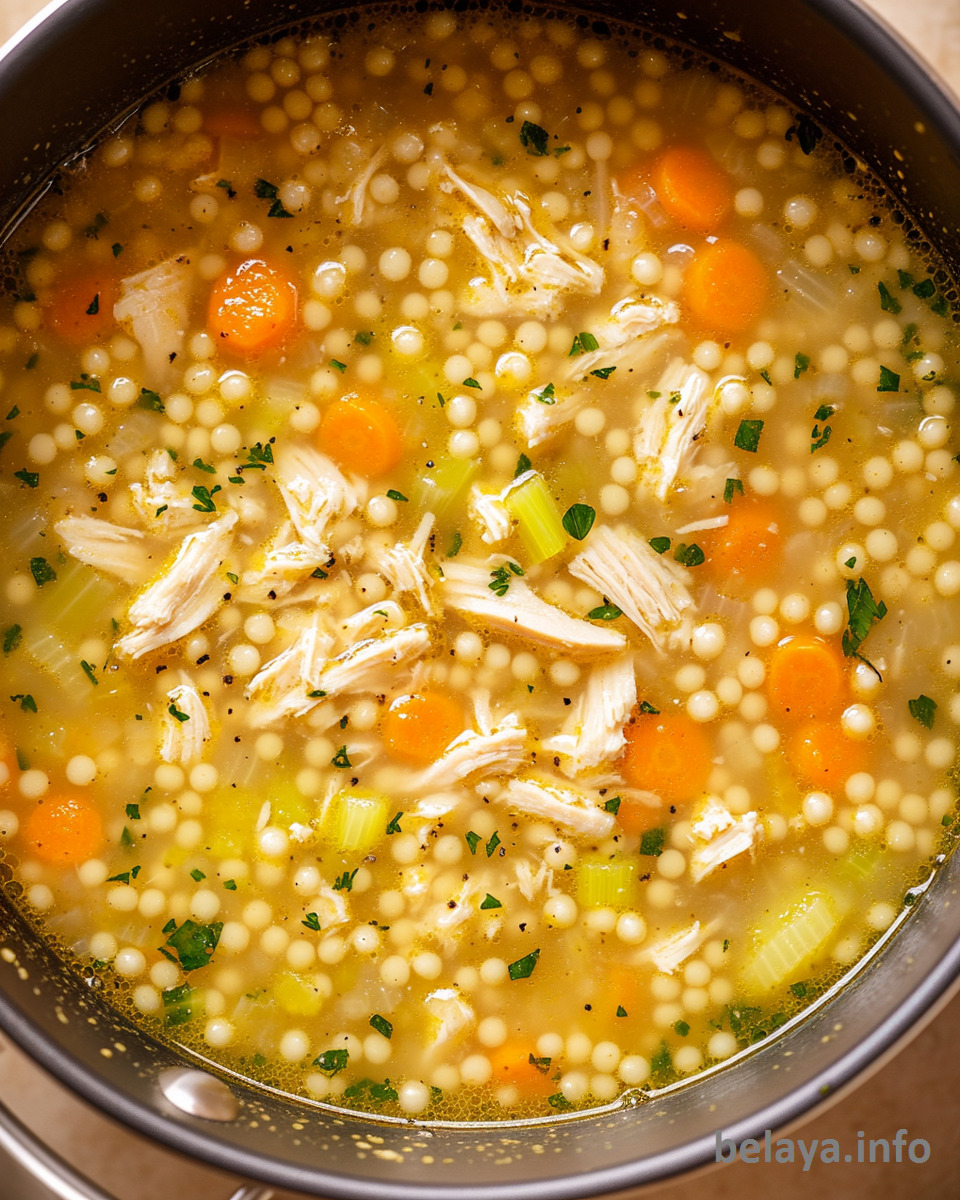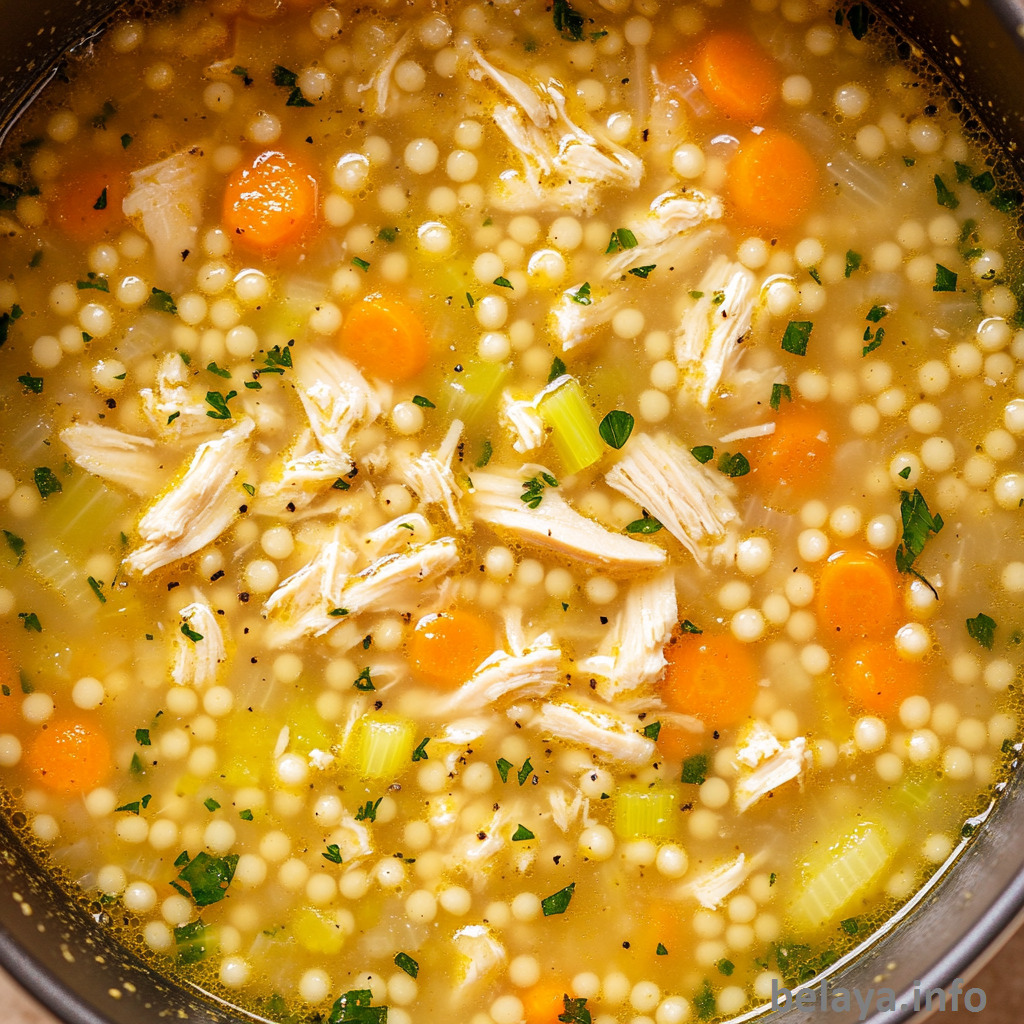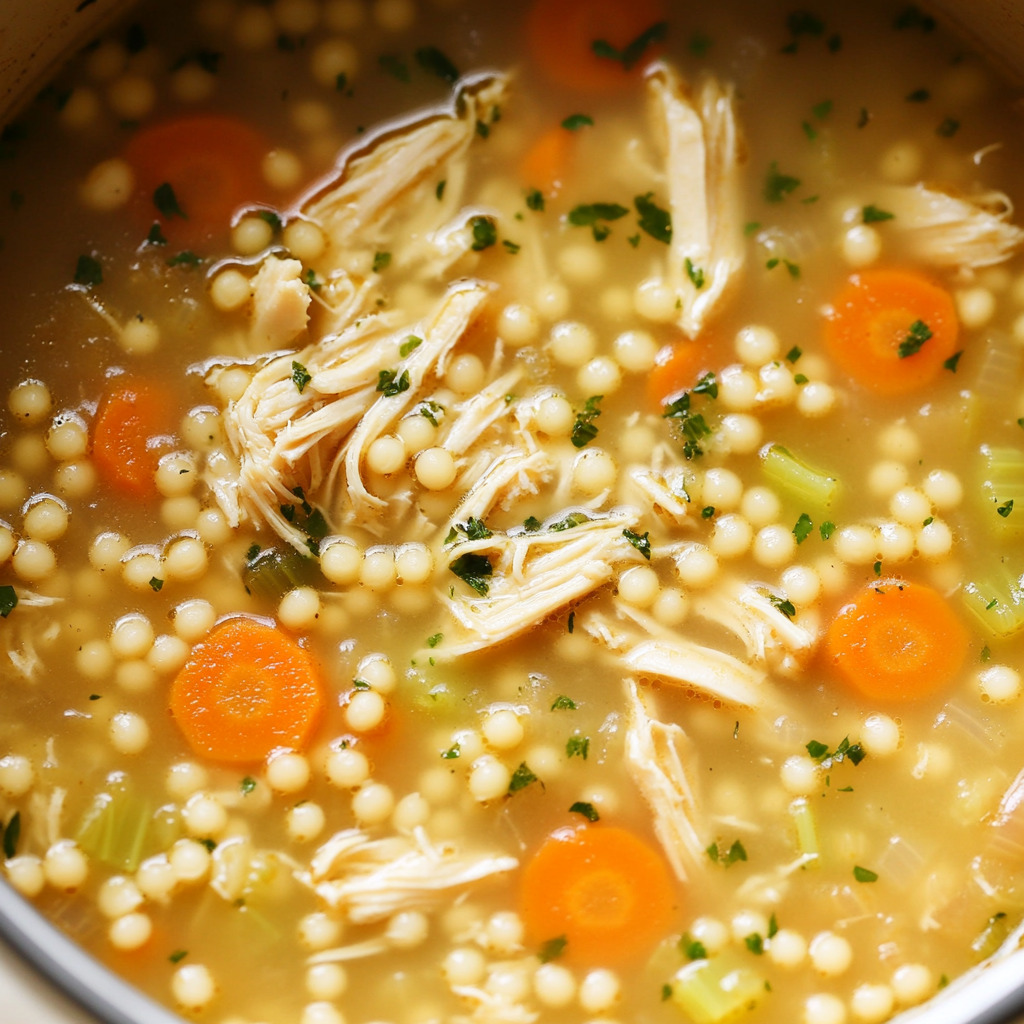Italian Chicken Pastina Soup
This Italian Chicken Pastina Soup is the kind of soul-warming comfort food that brings simplicity and nourishment to the table.
Rooted in Italian tradition, it’s made with tender vegetables, shredded chicken, and delicate pastina—the tiniest of pasta that adds a soft, velvety texture to each spoonful. The broth is rich yet light, simmered with aromatics and finished with a sprinkle of Parmesan for depth and warmth.
It’s the perfect dish for cozy nights, healing sick days, or anytime you crave a hug in a bowl.

Why People Will Love Italian Chicken Pastina Soup:
Deeply Comforting and Nourishing
This soup offers a warm, soothing experience that feels like a hug from the inside—perfect for chilly days, recovering from illness, or simply winding down after a long day.
Timeless Italian Tradition
With humble ingredients and classic preparation, it channels the nostalgic flavors of nonna’s kitchen—simple, honest, and full of heart.
Perfect Texture from Pastina
The tiny pasta adds a delicate, velvety bite that makes each spoonful more satisfying and unique than your typical chicken noodle soup.
Balanced and Customizable
Light yet hearty, it’s packed with protein, vegetables, and broth—easily adaptable for low-sodium, gluten-free, or vegetarian diets with small tweaks.
Great for Meal Prep and Leftovers
This soup stores and reheats beautifully, often tasting better the next day. It’s ideal for batch cooking, freezing, or making ahead for busy weeks.

Key Ingredients:
Pastina (Tiny Pasta): This delicate pasta—often in the form of acini di pepe or stelline—gives the soup its signature texture. It gently thickens the broth while adding a soft, pillowy bite that makes the soup both cozy and satisfying.
Shredded Chicken: Whether from a rotisserie chicken or leftover roast, the tender shreds of chicken infuse the broth with richness and protein, transforming this into a full, nourishing meal.
Carrots, Celery, and Onion (Soffritto): This classic trio is the aromatic foundation of Italian soup-making, adding subtle sweetness, earthiness, and depth to every spoonful.
Garlic and Fresh Herbs: A touch of garlic adds warmth and boldness, while optional fresh parsley and thyme bring brightness and a fragrant finish that balances the savory broth.
Olive Oil and Butter: The combination of both fats enhances the base with a balance of richness and smoothness, elevating the flavor of the sautéed vegetables.
Chicken Stock, Broth, and Water Blend: Using a trio of liquids offers both body and clarity in the broth—stock adds depth, broth adds savoriness, and water softens the saltiness for a balanced spoonful.
Parmesan Cheese: Grated fresh over the bowl, Parmesan adds umami and creamy richness, finishing the dish with a quintessential Italian flourish.

Expert Tips:
Build Flavor with a Slow Sauté (Soffritto Matters)
Take your time when cooking the onions, carrots, and celery—the longer and gentler the sauté, the more natural sweetness and depth they develop. Let them sweat and soften slowly rather than rush into the boiling stage. This step lays the foundation for a more flavorful broth.
Use Bone-In Chicken for Deeper Broth (If Not Using Rotisserie)
If you’re not using leftover or rotisserie chicken, consider simmering bone-in chicken thighs or a split breast directly in the broth. The bones enrich the stock with collagen and body, creating a more luxurious mouthfeel and authentic Italian flavor.
Salt Gradually and Taste Often
Start with less salt and build as the soup cooks. Between the broth, Parmesan, and possibly seasoned rotisserie chicken, salt levels can rise quickly. Season thoughtfully to avoid overpowering the delicate pastina and vegetables.
Cook Pastina Separately for Make-Ahead
If you’re prepping this soup for later or storing leftovers, cook the pastina separately and add it just before serving. Pastina absorbs liquid as it sits, and while that can make a deliciously thick stew, it may not be the texture you want after refrigeration.
Finish with Freshness and Fat
A final drizzle of good-quality extra virgin olive oil, a handful of fresh parsley, and freshly grated Parmesan just before serving adds complexity, brightness, and depth. This final touch balances the rich broth with light herbal and nutty notes.

Italian Chicken Pastina Soup
Ingredients:
2 tablespoons extra virgin olive oil
1 tablespoon butter
1 medium sweet onion, finely diced
4 medium carrots, peeled and sliced into 1/4 inch rounds
4 stalks celery, finely diced
4 medium cloves garlic, minced (2 tsp of jarred minced garlic works)
10 cups liquid (use a blend of 1/3 chicken stock, 1/3 chicken broth, and 1/3 water)
3/4 teaspoon kosher salt (or more, to taste)
2/3 to 1 cup uncooked pastina (tiny pasta; increase amount for a heartier soup)
2½-3 cups shredded rotisserie or leftover chicken (or baked chicken breast, shredded)
Grated Parmesan for serving
Fresh parsley and thyme for seasoning (optional)
Instructions:
Step 1: Sauté the Vegetables
In a large soup pot or Dutch oven, heat the olive oil and butter over medium heat.
Once hot, add the diced onion, celery, and carrots.
Stir occasionally and cook for about 4-5 minutes until the onions turn translucent.
Add the garlic and cook for another 2 minutes, stirring frequently.
Step 2: Add Liquids and Simmer
Pour in the chicken stock, broth, water, and salt.
Stir the mixture and bring it to a boil.
Once boiling, reduce the heat to a gentle simmer and cook uncovered for 25-30 minutes, or until the vegetables are tender.
Step 3: Cook the Pasta
Add the uncooked pastina to the soup. Increase the heat and bring the soup back to a boil, then reduce it to a steady simmer.
Cook the pasta according to the package instructions (typically around 9 minutes for Acini de pepe).
Step 4: Add Chicken
Once the pasta is cooked, stir in the shredded chicken.
Cover the pot and let the soup rest for about 20 minutes to allow the flavors to meld together.
Step 5: Taste and Adjust
Taste the soup and adjust the seasoning, adding more salt if needed.
Step 6: Serve
Ladle the soup into bowls and garnish with grated Parmesan, fresh parsley, or thyme.
Finish with freshly ground black pepper and serve with crusty bread or rolls on the side.
Enjoy!

Important Notes When Making Italian Chicken Pastina Soup
Pastina Cooks Quickly—Watch It Closely
Pastina is very small and delicate; it can easily go from perfectly tender to mushy if overcooked. Start checking it a minute or two before the package time, and remove the pot from heat once it’s just al dente.
Balance Broth Strength with Water
Using a mix of chicken stock, broth, and water provides depth without being overly salty or rich. If using store-bought broth, taste before adding salt—some brands are quite high in sodium, which can quickly overwhelm the soup.
Use Fresh Herbs for a Clean Finish
While optional, fresh parsley or thyme added at the end lifts the soup and balances the richness. Avoid adding them too early—they lose their brightness if simmered too long.
Resting the Soup Enhances Flavor
After adding the chicken and turning off the heat, let the soup sit covered for 15–20 minutes. This resting time allows the flavors to meld and the pastina to finish softening without breaking down.
Great for All Ages and Stages
Pastina soup is soft, soothing, and easy to digest—making it perfect for children, the elderly, or anyone recovering from illness. It’s comforting, simple, and incredibly nourishing.

Nutrition Information for Italian Chicken Pastina Soup,
Based on 1 serving out of 8 total portions from the full recipe:
Calories: 265 kcal | Total Fat: 10.8 g | Saturated Fat: 2.4 g | Monounsaturated Fat: 5.7 g | Polyunsaturated Fat: 1.3 g | Cholesterol: 55 mg | Sodium: 520–600 mg (depending on broth and added salt) | Total Carbohydrates: 21.3 g | Dietary Fiber: 2.7 g | Sugars: 4.6 g | Protein: 20.1 g
Note: This is an approximation using standard rotisserie chicken, olive oil, and average sodium broth. For precise tracking, adjust based on your ingredient brands and quantities.

Frequently Asked Questions:
Can I use a different type of pasta instead of pastina?
Yes, you can substitute pastina with other small pasta shapes like orzo, ditalini, acini di pepe, stelline (star pasta), or even couscous. Just adjust the cooking time based on the pasta type to ensure it remains tender but not mushy.
Can I use raw chicken instead of cooked or rotisserie?
Absolutely. You can simmer bone-in or boneless chicken breasts or thighs directly in the broth during the 25–30 minute simmer step. Once cooked through, remove the chicken, shred it, and return it to the pot during the final stage.
Will the soup thicken as it sits?
Yes. Pastina absorbs broth as it rests, especially after refrigeration, which can make the soup much thicker the next day. To restore the desired consistency, simply add a splash of water or broth when reheating.
Can I freeze Italian Chicken Pastina Soup?
You can freeze the broth and chicken mixture without the pasta. Cooked pastina tends to turn mushy when thawed and reheated. For best results, freeze the base and add fresh pasta when reheating.
What can I serve with this soup to make it a full meal?
This soup pairs beautifully with crusty Italian bread, garlic knots, or a simple green salad. For a heartier meal, serve with a side of roasted vegetables or a caprese-style appetizer.
Should I cook the pastina directly in the soup or separately?
You can cook it directly in the soup for convenience and extra flavor, but if you’re planning to store leftovers, it’s better to cook the pastina separately and add it to individual portions. This prevents the pasta from over-absorbing the broth and becoming mushy over time.
Why use a blend of broth, stock, and water instead of just broth?
Combining stock, broth, and water balances the soup. Stock adds richness, broth brings seasoned depth, and water prevents the overall flavor from becoming too salty or overpowering. It’s especially useful when using store-bought broth, which can be high in sodium.
How do I avoid overcooking the vegetables?
Add all the chopped vegetables at once and simmer gently—not at a full boil—for about 25–30 minutes. This allows the carrots and celery to soften evenly without breaking down or becoming mushy. Avoid cooking pastina and veggies together too early.
When should I add the chicken to keep it moist?
Add the pre-cooked or shredded chicken at the very end, after the pasta is fully cooked. Then turn off the heat, cover the pot, and let the soup rest for 10–20 minutes. This method gently reheats the chicken without drying it out or making it stringy.
How do I deepen the flavor without adding more salt?
Add a Parmesan rind during the simmering step—it infuses the broth with a savory, umami-rich depth. You can also stir in a drizzle of extra virgin olive oil or a small pat of butter at the end for richness, without relying solely on salt.